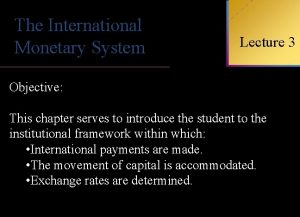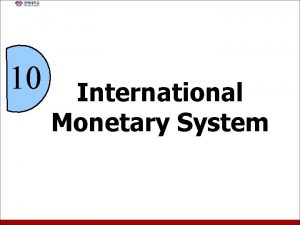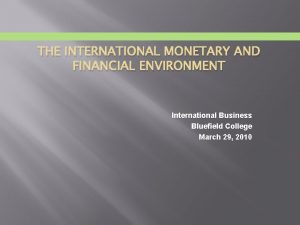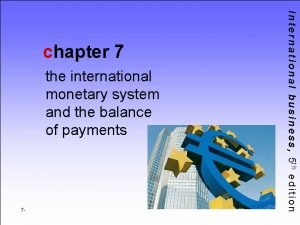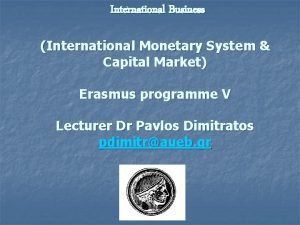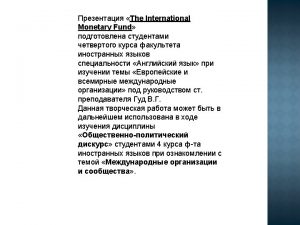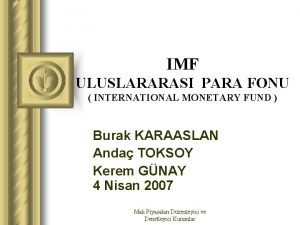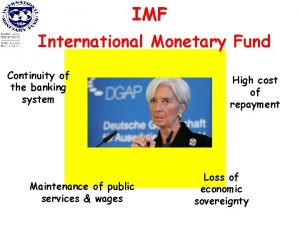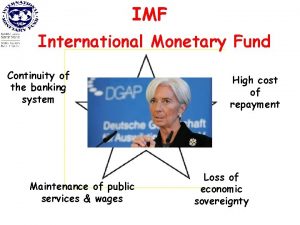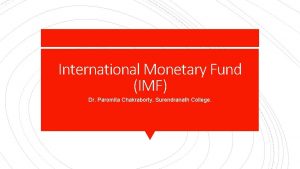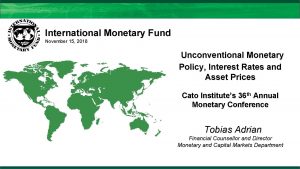THE INTERNATIONAL MONETARY FUND INTRODUCTION IMF is a












- Slides: 12


THE INTERNATIONAL MONETARY FUND

INTRODUCTION IMF is a forum of national economic policies, international monetary and financial systems, which involves active dialogue with each member country. When there is a country where has a serious finance problem, other countries loan the money for the poor country. IMF is a kind of association among the countries to prepare the situation when the nation bank of country is bankrupted. IMF is an administrative unit that is international in nature and whose objective is to regulate and administer the financial system of the world.

HISTORY OF IMF v. The International Monetary Fund was created in 1944, at the Bretton Woods conference to prevent the kinds of chain reaction in the economic system that caused world currencies to collapse like in the Great Depression of the 1930 s. v Bretton wood agreement was contracted in 1944 and IMF was created in 1946. v IMF started to make service with IBRD (international bank of reconstruction and development) in 1947. v. The IMF was created to support orderly international currency exchanges and to help nations having balance of payment problems through short term loans of cash.

ABOUT IMF ØIMF headquarters is in Washington D. C , U. S. A ØFive largest shareholders are United States, Japan, Germany, France, United Kingdom. ØChina, Russia, and Saudi Arabia have their own seats on the Board. Ø 16 other Executive Directors are elected for two year terms by groups of countries, known as “Constituencies”. Ø Total quotas of $312 billion; outstanding loans of $71 billion to 82 countries (According to the report of August 31, 2005). Ø The International Monetary Fund (IMF) is an organization of 186 countries.

GROWTH IN IMF MEMBERSHIP (19452003) v. At the beginning 29 member countries v. Today, 186 member countries. v. Staff of about 2680 persons. v. Two-thirds are economists in 139 countries.

IMF promote international monetary cooperation. expansion and balanced growth of international trade. IMF promote exchange rate stability. help establish multilateral system of payments and eliminate foreign exchange restrictions. IMF make resources of the Fund available to members. Foster economic growth and high levels of employment. IMF can make the price of foreign money to be safe. IMF can solve the problem of countries that doesn’t want to allow the foreign money to make their currency’s value higher.

ROLE OF IMF § Focusing on its core macroeconomic and financial areas of responsibility. §Working in a complementary fashion with other institutions established. § Collection and allocation of reserves. §Rendering advice to member countries on their international monetary affairs. §Promoting research in various areas of international economics and monetary economics. § Providing a forum for discussion and consultation among member countries. §Being in the center of competence.

• Surveillance (like a doctor) Gathering data and assessing economic policies of countries. • Technical Assistance (like a teacher) Strengthening human skills and institutional capacity of countries. • Financial Assistance (like a banker) Lending to countries to support reforms

MEMBERSHIP AND GOVERNANCE Ø 186 Member States ØBoard of Governors (1 from Each State) ØManaging Director ØExecutive Board (24 Members) ØWeighted Voting System: o. US Representative holds 17% of total Voting Power o 27 Countries together hold 1. 4% of total Voting Power o. Decisions are most often made by consensus, rather than fractious parliamentary fights. ØBoard of Governors: one governor from each member country. Meets once a year. ØDay to day affairs are guided by the Executive Board & 24 Executive Directors. Managing Director of IMF is Chairman of Executive Board.


CONCLUSION The IMF works to foster global growth and economic stability. It provides policy advice and financing to members in economic difficulties and also works with developing nations to help them achieve macroeconomic stability and reduce poverty.
 International monetary fund apush
International monetary fund apush International monetary fund
International monetary fund International monetary fund
International monetary fund International monetary system
International monetary system Objectives of international monetary system
Objectives of international monetary system International monetary and financial environment
International monetary and financial environment International monetary and financial environment
International monetary and financial environment International monetary system
International monetary system International monetary system
International monetary system Imprest and fluctuating
Imprest and fluctuating Imf history
Imf history Imf adalah
Imf adalah Imf chem
Imf chem



